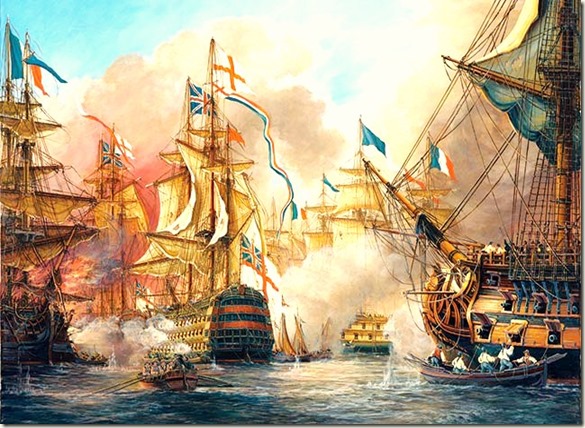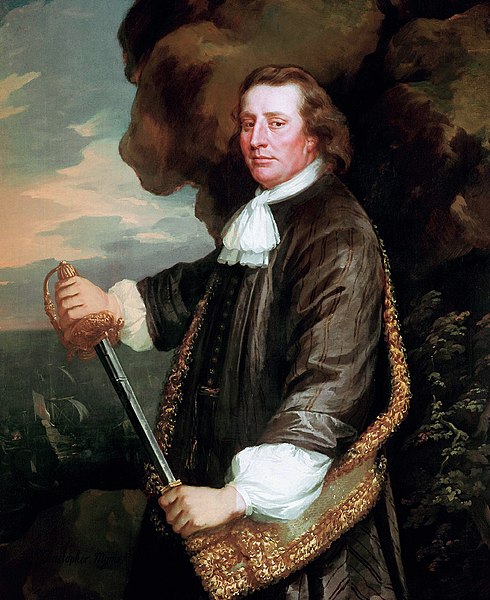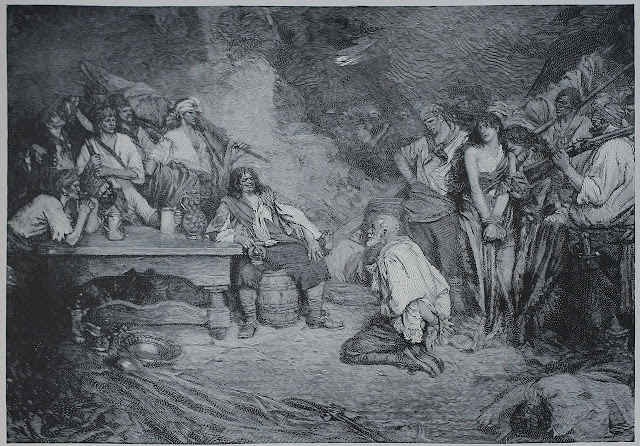Privateers, Buccaneers, Pirates & War

England had long used the practice of issuing commissions (letters of marque) to private vessels as a way of augmenting its navy in times of war. After 1665, however, Caribbean privateering took a more ambiguous form: buccaneers. Located as it was, at the heart of Spanish America, Jamaica was vulnerable to attack from England’s enemies—chiefly, though not solely, Spain. It is doubtful the island would have remained English had it not been for its privately commissioned navy under the command of men like Edward Mansfield and Henry Morgan. From their base at Cagway (Port Royal) on the south coast, privateers were often the only navy Jamaica had to place between itself and its enemies. Historian, Edward Long, wrote: “It is to the Bucaniers [sic] that we owe the possession of Jamaica at this hour.”
The buccaneers, as these Englishmen were known, (the French used the term filibuster) started as hunters of wild cattle and boar on the island of Hispaniola. The animals they hunted had been abandoned by Spanish settlers who had left Hispaniola and moved to the American mainland in search of gold and other quicker sources of wealth. The term itself came from a Carib word, bukan, for the method Caribs used to cook and dry meat.
The hunters came from all walks of life, many a step ahead of the law. They were predominantly French but with significant numbers of English and Dutch. Eventually, the Spanish drove the hunters from Hispaniola, and they took refuge on the tiny offshore island of Tortuga. And, by the time the Spaniards ousted them from there, buccaneers and filibusters had developed a hatred for the Spanish.
 |
| A Hispaniola buccaneer as seen by a French artist |
After Spain put an end to their tradition of hunting, the hunters became buccaneers: sea-raiders who called themselves “Brethren of the Coast,” and who used small, shallow-drafted boats to prey on Spain’s coastal settlements and shipping lanes. Most were open boats, many were no more than large canoes, known as piraguas.
Although buccaneers were scrupulously honest when dealing with communal property, many were ruthless, fearless, lawless rogues capable of chilling cruelty. They expected no quarter and gave none. They sailed under a stern code of discipline documented in articles, the principal one of which was, “No purchase, no pay.” Plunder was pooled and shared according to their articles. Extra compensation was given to those who performed acts of conspicuous courage or became disabled during an engagement.
Life in a piragua was far from pleasant for most, but these were a special breed of men who were used to a tough life and harsh environments. Some were strong, sturdy men who had cut logwood at Campeche and were known to carry three or four hundredweight. Others had been indentured workers on farms and plantations where they’d toil for hours under the scorching tropical sun. They would sit upon their benches, rowing with long, slow strokes for hours without complaint or sign of fatigue. Nearly all were above average in strength and had been in the tropics long enough to have become acclimatized.
In the late 1650s, the English buccaneers, at the urging of the governor of Jamaica, chose Cagway (renamed Port Royal in 1660) as their main base. And by the time England had consolidated its foothold on Jamaica, the buccaneers were loosely integrated into that island’s military and naval forces. By 1659, two hundred houses, shops and warehouses were clustered near Fort Charles, which the English built as soon as they had gained control of the port. In less than a decade, the buccaneers had grown to the size of a national navy. Besides the English buccaneers who had chosen Port Royal as their home base, about 1,500 French flibustiers were based in Tortuga.
The buccaneers maintained an uneasy alliance with the Caribbean colonies for they needed a place to dispose of their plunder and from which to obtain supplies. The colonist for their part needed protection from their Spanish neighbours, and they benefitted economically from the rock-bottom prices they paid for Spanish loot and the sky-high prices they charged the carousing buccaneers
 |
| Christopher Myngs (1625–1666) | by Sir Peter Lely |
Buccaneers cruised mainly in separate companies, usually of less than one hundred men. They raided Spanish settlements and captured their ships. Individual leaders included Bartholomew Portugues, Roche Brasiliano, Lewis Scott, John Davis, Richard Guy, Sir Thomas Whetstone (a cousin of Crom-well), John Morris, David Martien, Jacob Jackman, Thomas Freeman and dozens more. Eventually, the buccaneers banded together to form a powerful fleet capable of taking on heavily fortified Spanish settlements and cities.
In the early days, the buccaneers sailed under the command of Vice-Admiral Sir Christopher Myngs, the commander of the small English naval force in Jamaica. Later, command passed to one of their own, a Dutchman named Edward Mansvelt. He was known to the English as Edward Mansfield. In time, leadership would pass to the most famous buccaneer of all, Sir Henry Morgan.
 |
| Sir Henry Morgan (1635 – 1688) Henry Morgan as a young man, © Data Wales 2001 This portrait is on display at Tredegar House, Newport, Wales, UK |
By 1692 five forts defended the harbour at Port Royal. Before long, the town had earned the reputation as being the “wickedest town in the world.” From 1665 to 1675—Henry Morgan’s heyday—it may also have been the richest town in the world, for between 1665 and 1671 the buccaneers sacked eighteen Spanish American cities, four towns, thirty-five villages and captured ships too numerous to count. Much of the plunder so obtained flowed through Port Royal. With the death of Sir Henry Morgan in 1688 and the destruction of Port Royal on June 2, 1692—when a violent earthquake sunk two-thirds of the town—the era of the buccaneer was drawing to an end.
The buccaneer era spanned a period in the seventeenth century from some date prior to 1630 to the signing of the Treaty of Ryswick in 1697. They came later than, and should not be classified with, the Elizabethans: Drake, Hawkins, Raleigh, Gilbert, Grenville and Frobisher. Nor are they to be included in the Pirate Era that succeeded them, for men like John Rackham, Edward Teach, “Blackbeard”, and Bartholomew Roberts, “Black Bart”, were simple sea robbers who were not acting under legal government commissions.
 |
| Morgan at Porto Bello | Originally published in Pyle, Howard (December 1888). Buccaneers and Marooners of the Spanish Main | Harper’s Magazine |
In 1697, Spain formally recognized all English and French-occupied territories in the West Indies, ending the need for mercenaries to protect the islanders from attack by Spain. Port Royal survived as a naval station, but its economic activity moved to a nearby settlement, Kingston, which would later become Jamaica’s capital.
I plan offer a more detailed treatment of the much-maligned and libelled, Welch-Jamaican hero, Sir Henry Morgan, in the future.
Taking advantage of the confusion caused by the destruction of Port Royal in 1692, a large French force attacked the eastern part of the island. Under Admiral Jean du Casse, the French ravaged the countryside before being engaged by Jamaica’s defence force who killed 700 of the invaders. Several plantations and sugar works were burnt, however, and hundreds of slaves and other valuable property taken away.
 |
| Jean Baptiste du Casse | Attrib. to Hyacinthe Rigaud |
The 18th century was an eventful time for Jamaica. The island was virtually self-governing and its planters (along with those of Barbados) controlled an influential block of votes in the parliament of England. It was also a savage time that saw numerous slave revolts, attacks by pirates, Maroon attacks on plantations, epidemics and violent hurricanes that cost much in lives and property. Jamaica, I believe, had more slave revolts than all other British Caribbean islands combined.
Following the War of the Spanish Succession, Jamaica had less, if any, need for the protection of Buccaneers/privateers. These freebooters had, in fact, become bad for the trade between Jamaica and the nearby colonies of Spain. As a result, many former privateers became pirates who plagued the Caribbean in growing numbers. And, while the Buccaneers had protected Jamaica from Spain and attacked mainly Spanish settlements and ships, the pirates of the 18th Century made no such distinction. These operated not just in the Caribbean and the North American eastern seaboard, but also all the way to the West African coast and the Indian Ocean. Notorious pirates of the day who were Jamaicans or who had connections to the island included Nicholas Brown, Christopher Winter, Edward Teach (known as “Blackbeard”), Captain Charles Vane and Captain Jack Rackham (known as “Calico Jack”). Interestingly, sailing with Rackham were two female pirates, Mary Read and Anne Bonney. They preyed on coastal vessels and plundered isolated plantations.
The War of Jenkin’s Ear broke out in 1739 when England declared war with Spain over the habit the Spanish Guarda Costas had of stopping and searching English ships looking for illegal trade, and their subsequent ill-treatment of the English crews. Several campaigns were mounted from Jamaica, most with disastrous results. In all, some 20,000 British lives were lost before the war ended in 1748 with the Treaty of Aix-la-Chapelle. Next came the Seven Years War in which nearly every island France had in the West Indies fell to the British. This war ended in 1763 with the signing of the Treaty of Paris. Tensions in Jamaica remained high throughout the last third of the 18th century. Other significant events included a terror campaign by the notorious bandit, Three-Fingered Jack. Devastating hurricanes and the American War of Independence added to the general sense of turmoil.
A heritage sign placed by Jamaica National Heritage Trust beside the road that leads from Kingston to St. Thomas In the early 1780s, Three-Fingered Jack Mansong formed a runaway community in the parish of St Thomas-in-the-East. Some historians believed that Jack operated as a sole bandit—a Jamaican Robin Hood—but he was more likely the leader of a band of runaway slaves that so harried the Jamaican authorities they offered a reward for his capture.
In 1781, Three-Fingered Jack was killed by a party of Maroons led by the White superintendent of Scott’s Hall. His name was Bernard Nalty, and his party of Maroon warriors from Charles Town included John Reeder, Samuel Grant and a young Maroon warrior named Little Quaco. These Maroons were already freedmen when they killed Jack.
The most significant slave revolt in Jamaica up to the end of the 18th Century was Tacky’s War or Tacky’s Rebellion, which was an uprising of slaves that occurred from May to July 1760. I covered this briefly in an earlier instalment and so I won’t deal much more with it here, other than to say colonial officials put down the revolt and others it inspired quickly and mercilessly.
While Britain was preoccupied with the American colonists, Spain and France avenged their previous losses in the Caribbean. By 1782, the year following the surrender of the British forces at Yorktown, only Jamaica, Barbados and Antigua remained in British hands.
 |
| George Brydges Rodney by Joshua Reynolds in 1789 |
On 09 April 1782, Admiral George Rodney intercepted a joint Spanish and French fleet off the island of Dominica. The fleet was on its way to invade Jamaica. The battle lasted three days and ended in victory for Rodney who took his prizes to a jubilant reception at Kingston.
Towards the end of the century, Horatio Nelson was stationed in Jamaica where he commanded the batteries at Port Royal’s Fort Charles in preparation for an invasion by the French that never materialized. Later he led an expedition to Nicaragua which failed when two-thirds of his forces were wiped out by yellow fever.
Jamaica’s 1831 Baptist War, also known as the Great Jamaican Slave Revolt of 1831–32, was the largest slave uprising ever in the British West Indies. It started peacefully enough on Christmas Day 1831 when about 60,000 of Jamaica’s 300,000 slaves went on strike under the leadership of a Baptist preacher and fellow slave, Samuel Sharpe. Their aim was to withhold labour until they were awarded basic freedoms and a living wage. As rumours spread about a British plan to use force, however, the strike escalated to outright rebellion.
Slaves burned and looted plantations for eight days, causing tens of thousands of pounds in property damage. The colonial army finally put down the revolt, but only after 300 slaves and 14 Whites had been killed. Sharpe and 300 more slaves were hanged for their involvement. The Baptist War might have hastened abolition, for only a year later, the British Parliament abolished slavery throughout the Empire.
We’ll end here, but before closing, I’m providing a partial list of books about privateers and pirates and about the colourful history of Port Royal. Most of these are now hard to get, but those interested in further research may find some through book dealers who carry out-of-print books or from Internet sources:
- Terry Breverton, Admiral Sir Henry Morgan: King of the Buccaneers (Pelican, 2005)
- James Burney, History of the Buccaneers of America, (London, 1816)
- David Cordingly, Under the Black Flag, (1st Harvest ed., 1997)
- Peter Earle, The Sack of Panamá, (London, 1981), which includes some excellent research using Spanish archives, giving quite a different and helpful perspective
- John Esquemeling, The Buccaneers of America, (Rio Grande, 1992) — 1st published in 1684
- Philip Gosse, The Pirates’ Who’s Who, (New York, 1924)
- Clarence Henry Haring, Buccaneers in the West Indies in the XVII Century (1910)
- Captain Charles Johnson, A General history of the Robberies & Murders of the Most Notorious Pirates, (Lyons, 1998) — 1st published in 1794
- Benerson Little, The Buccaneer's Realm (Washington: Potomac, 2007)
- David F. Marley, Pirates and Privateers of the Americas, (ABC-CLIO, 1994)
- Robert F. Marx, Port Royal Rediscovered (Doubleday, 1973)
- John Masefield, On the Spanish Main (London: Methuen, 1906)
- The National Archives of the UK (TNA) – Calendar of State Papers, Colonial, America and West Indies (online summaries of the papers of the English secretaries of state relating to colonial affairs from the 16th to the 18th century)
- Michael Pawson and David Buisseret, Port Royal, Jamaica (Oxford, 1974 or 2d ed. UWI, 2000)
- Dudley Pope, Harry Morgan's Way (Alison, 1977)
- Alfred Sternbeck, Filibusters and Buccaneers (1930)
- Alexander Winston, Pirates and Privateers (Arrow, 1972)


Comments
Post a Comment